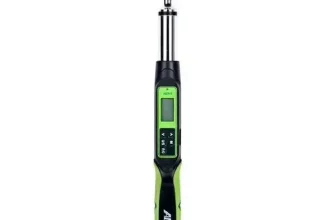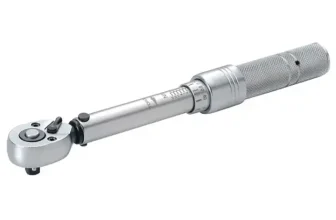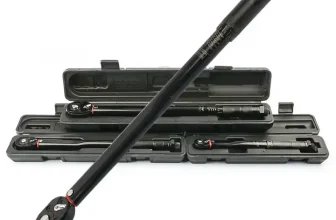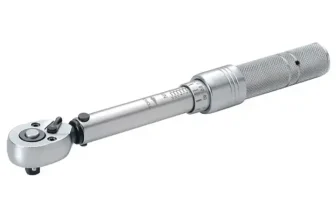A torque wrench is a specialized tool designed to apply a specific
amount of force, or torque, to a fastener such as a nut or bolt. This
specific tool is designed to prevent over-tightening, which can cause
damage to parts or components, as well as under-tightening that can
cause fasteners to come loose in operation.
Torque wrenches are commonly used in a variety of applications,
including automotive repair, where they are essential in ensuring bolts
and nuts are tightened to the manufacturers’ exacting specifications,
ensuring vehicle safety and reliability. Other fields where torque
wrenches are used include construction, manufacturing, and even in some
home DIY projects—virtually anywhere there’s a need for precision
tightening.
By understanding and regulating the amount of torque applied, users
can ensure a proper fit and seal, promoting both the safety and
longevity of their projects. Because of their central role in many
applications, owning a properly calibrated torque wrench is a crucial
aspect of many trades and projects.
The importance of
correct torque application
Successful operation and longevity of any mechanical system lie
heavily on the correct assembly of its components. One key aspect of
this assembly is the application of the right level of torque when
tightening fasteners such as screws or bolts. The importance of correct
torque application cannot be stressed enough.
Applying the correct torque ensures that the components are held
together with the appropriate amount of pressure, promoting structural
stability, and reducing the chance of fasteners failing or becoming
loose over time. Too little torque and the fasteners may not hold the
components securely, risking sudden disassembly. Too much torque, on the
other hand, can cause equally detrimental consequences such as stripping
threads or even causing damage to the parts themselves due to excess
force.
Given that a multitude of industrial and home-based projects rely on
the carefully balanced application of torque, it follows that the device
used to measure and apply this force–in this case, the torque wrench–
must be accurate and reliable. This brings us to the need for regular
calibration of torque wrenches, which we will delve into as we progress
in this discussion.
Understanding Calibration
What does calibration mean?
Calibration, in the context of a torque wrench or any other measuring
instrument, involves adjusting the device to provide a reading or output
that matches a known and standardized value. This procedure is crucial
to ensure the measurements provided by the wrench are as accurate as
possible. Just like a traditional scale needs to be zeroed out before
accurately measuring weight, the torque wrench needs to be periodically
calibrated to ensure it’s applying the correct amount of force.
Calibration keeps the tool within the acceptable range of accuracy as
determined by industry standards, thus ensuring safe and effective
use.
Why
calibration is necessary for torque wrenches
Calibration is crucial for torque wrenches due to certain reasons.
The fundamental purpose of calibration is to ensure accuracy. When
torque wrenches are used for tightening various bolts and nuts,
delivering the correct amount of torque is paramount. Under-torque can
lead to loose bolts or nuts, which can cause an assembly to fall apart,
while over-torque can lead to excessive stress and potential damage to
components.
Moreover, calibration significantly diminishes the risks of over or
under-tightening. The torque wrench is a precision tool, and any
discrepancy in its measurement can be detrimental to the tasks it is
utilized for. As such, only regular calibration can assure that a torque
wrench holds true to its indicated value thereby safeguarding the
reliability of the work it performs.
Lastly, calibration can prolong the lifespan of the tool. By
regularly checking and adjusting the instrument, wear and tear,
typically caused by inaccuracy, can be minimized, ensuring a longer
useful life for the torque wrench. Thus, calibration is not just a
process to assure accuracy, but also a maintenance tip for making the
most of your torque wrench.
Factors affecting
Torques wrench’s accuracy
Usage frequency
The frequency at which a torque wrench is used can impact its
accuracy over time. Like any tool, consistent high-volume usage can lead
to wear and tear, eventually causing the wrench to operate less
precisely than it should.
For torque wrenches used on a daily basis, the constant strain on the
internal mechanisms may hasten their deterioration, leading to
inaccurate torque application. In contrast, those used less frequently
may retain their accuracy for longer periods. This factor, though
dependent on the quality of the wrench and its internal components, is
an important point to monitor.
Accumulation of grit, dirt, or other small particles caused by
frequent usage can also hamper the wrench’s performance. These particles
can interfere with the mechanical functions within the tool, leading to
inaccurate calibrations. Regular maintenance and cleaning can help
combat this but won’t completely eliminate the inevitable wear from high
usage.
Therefore, even though a frequently used torque wrench might still
function well in applying torque, it may not offer the same precision as
when it was new. It’s essential to keep track of usage intensity to
anticipate when calibration may be necessary.
Rough handling
Rough handling of torque wrenches can significantly impact their
accuracy. Excessive force, dropping the tool, or misuse can lead to
internal damage, which in turn may cause the wrench to provide
inaccurate readings. Over-tightening past the wrench’s capacity is a
common form of misuse that can cause significant damage. It’s also
essential to store the wrench properly when it’s not in use; leaving it
in environments prone to high impact can cascade to further damage and
inaccuracies. Proper handling and storage are crucial to maintaining the
long-term accuracy of your torque wrench.
Environmental conditions and
age
The age of a torque wrench and its exposure to various environmental
conditions can significantly affect its accuracy. Over time, like any
other tool, a torque wrench can undergo wear and tear which can cause it
to lose some of its original accuracy. Regular use, especially in
heavy-duty applications, can expedite this process.
Environmental factors also have a substantial impact. Working in
environments with high humidity or a lot of dust and dirt can affect the
inner workings of the wrench and disrupt its accuracy. Exposure to
extreme temperatures, either hot or cold, and corrosive substances can
likewise alter the functioning of the tool. If the wrench is not cleaned
regularly and properly stored in a dry, temperate environment it is more
likely to yield inaccurate torque measurements. Therefore, proper
maintenance and storage can go a long way in maintaining the accuracy
and extending the lifespan of your torque wrench.
Guidelines on Frequency
of Calibration
Standard industry
recommendations
The standard industry recommendations for calibrating torque wrenches
largely depend on the frequency and extent of use. As a rule of thumb, a
torque wrench that is regularly in use should be calibrated every 5000
to 7000 uses or once every 12 months, whichever comes first.
However, manufacturers of torque wrenches, like Snap-On and CDI,
usually provide specific guidelines on how often their products should
be calibrated. Some manufacturers recommend calibration after a certain
number of cycles or torque applications, such as 5000 or so, while
others may recommend recalibration after every year or so of usage.
However, these guidelines can be viewed as a minimum requirement.
More frequent calibration may be needed if the torque wrench is used
heavily or in critical applications where even a slight deviation in
torque could create issues.
For instance, a torque wrench utilized in an industrial setting that
sees daily high-torque use might require more regular testing and
calibration, sometimes even as frequently as every three months.
Ultimately, it’s crucial to abide by the manufacturer’s guidelines
and to align calibration frequency with the tool’s usage level to ensure
consistently accurate readings and the longevity of the instrument.
Variable
factors that may require more frequent calibration
While the industry standard is a reliable guideline, it’s crucial to
understand that the calibration frequency of a torque wrench can be
influenced by several variable factors. Each torque wrench usage can be
different, thus affecting its calibration intervals.
-
Intensity of Use: A torque wrench used frequently and subjected
to high levels of stress will require calibration more frequently. For
instance, if your torque wrench is used daily in a commercial or
industrial environment, it may require calibration every 3 to 6
months. -
Job Complexity: The precision requirements of the job at hand may
necessitate more frequent calibration. Jobs that demand high levels of
accuracy may require that the wrench be calibrated before each
use. -
Previous Calibration Results: Results from previous calibrations
can also provide valuable insight. If historical accuracy of the tool is
consistently off by a large margin, then it’s a good sign that more
frequent calibration is needed. -
Component Quality: The quality of the inner-mechanism and overall
construction of the torque wrench plays a major role too. While some
high-end torque wrenches maintain their accuracy over a longer period,
others tend to drift faster, demanding more frequent
calibration. -
Maintenance and Storage: Poor maintenance or storage can be
contributory factors as well. If a wrench is not properly cleaned after
use or stored in a harsh environment, its calibration could be
affected. -
Unexpected Readings: If you notice erratic or inconsistent
readings, it’s time to re-calibrate, regardless of when the last
calibration was done.
Remember, failure to calibrate a tool that is out of spec can lead to
improper applied torque which risks damaging equipment or compromising
safety. It’s always best to err on the side of caution. Prioritizing
accuracy can uphold the reliability and longevity of your torque
wrench.
Steps on Proper
Calibration of Torque Wrenches
Description of the
calibration process
Calibrating your torque wrench ensures it operates at its optimal
efficiency and delivers accurate readings. To perform this delicate
process, follow these steps:
-
Preparation: Clean the wrench before calibration
to remove any dust, grease, or rust. A clean wrench is more
accurate. -
Preset the Wrench: Preset the torque wrench to
its lowest setting. This resets the internal spring mechanism to its
least strained state. -
Align the Machine: Place the square drive of the
torque wrench into the calibration machine. Ensure the wrench is
horizontal and securely positioned. -
Load the Wrench: The calibration machine applies
force to the handle of the wrench. Start testing at the lowest level
(20% of the maximum range) and gradually increase. This is to ensure the
wrench provides accurate readings throughout its working range. -
Read the Results: The machine will display the
reading of the force applied versus the force the wrench perceives it’s
applying. From this, you can determine whether the wrench is
under-applying, over-applying, or perfect. -
Make Adjustments: In case of inaccurate
readings, adjustments should be made. This can be done by turning the
calibration screw on the wrench. -
Repeat the Test: After making adjustments,
repeat the test. Continue adjusting if necessary, until the readings are
accurate. -
Confirm calibration: Once the wrench is
determined to be accurate at its lowest setting, repeat this process at
mid-range and the highest settings. -
Documentation: Once completed, it is important
to document the calibration results for future reference.
Remember, calibration is not a one-size-fits-all process. Torque
wrenches vary significantly in design, functionality, and operations.
Therefore, always refer to your manufacturer’s instructions when
calibrating your specific tool.
Tools and materials
needed for calibration
For a successful torque wrench calibration process, you will need the
following tools and materials:
-
A torque wrench tester or a calibrated beam: This is essentially
the tool used to measure the torque output. It is required to be highly
precise and accurate. An alternative is a calibrated beam, which is a
reference beam with known weight ratings used for a similar
purpose. -
Calibration weights: These are required to apply known loads on
the torque wrench for precision in calibration. -
Mounting device or holder: This device helps hold the torque
wrench securely in place during the calibration process to keep it from
moving and possibly affecting the results. -
A clear, easily readable scale: A gauge or scale that shows clear
and precise measurements is necessary for calculating the differences
between set and actual measurements during the process of
calibration. -
Permanent marker and calibration sticker: Once your calibration
is complete, these will be used to clearly mark the torque wrench with
the calibration date and the date for the next anticipated
calibration. -
Data recording system or logbook: This enables you to track your
calibration results over time and can help you identify potential issues
before they become serious problems.
Remember, while these tools can be used to calibrate your torque
wrench at home, it’s always a good idea to seek professional guidance to
ensure your tools are operating at their maximum efficiency and
accuracy.
Professional Calibration
Services
When to consider
professional calibration
While regular calibration of torque wrenches using simple home
methods can keep them efficient to an extent, there are certain
occasions when professional calibration becomes imperative. The first
instance is post-rough handling. If your torque wrench has suffered a
significant fall or been used improperly – for instance, as a hammer –
it’s recommended to have it professionally calibrated. These types of
scenarios hasten wear and tear and could affect the accuracy of the
wrench.
Another sign that your wrench may need professional calibration is
inconsistent or unusual readings. If you’ve noticed your wrench is
delivering inconsistent results or the readings appear off, it’s time to
consider professional calibration. Inaccurate readings mean inaccurate
torque application, which not only compromises your work but also could
potentially damage the wrench.
Finally, you should consider professional calibration after a long
period of disuse. If you haven’t used your torque wrench for a while,
perhaps due to off-season or break in project, it’s a good idea to get
it professionally calibrated before you start using it again. In such
cases, even when not in active use, the tool could lose its calibration
due to factors like temperature changes, humidity and other
environmental factors. A professional calibration check can ensure your
wrench provides accurate measures.
Remember, professional calibration ought to be done by certified
experts and labs certified through a recognized accreditation body to
ensure the highest standards of accuracy.
Advantages and disadvantages
Professional calibration comes with a host of benefits. The primary
advantage is the accuracy and reliability, ensuring your torque wrench
is performing at its optimal level. Expert calibrators possess the
specific skills, knowledge, equipment, and experience necessary to
perform the job to a high standard. Another significant advantage is the
compliance aspect. Professional calibration services usually provide
certificates, which can be integral for meeting industry standards or
regulations.
On the flip side, there are two main disadvantages to consider.
Firstly, professional calibration services involve time. Depending on
the provider, you may have to deal with delays and interruptions of your
operations as you send off and wait for your tool to be returned.
Secondly, professional calibration can be costly, particularly if it’s
required frequently or you have many tools to calibrate. This expense
can be significant for smaller operations.
It’s important to weigh these advantages and disadvantages when
deciding between professional and DIY calibration. While professional
services offer accuracy and peace of mind, the associated cost and time
requirements might not be feasible for every situation.
Conclusion
Recap of
the importance of torque wrench calibration
Calibration is an integral element in ensuring torque wrenches
deliver the required force to tighten bolts and nuts accurately. Through
regular calibration, tool users can maintain the standard of precision
they need to carry out their tasks, safeguarding the reliability and
longevity of these vital tools.
Inadequately torqued fasteners can commonly result in mechanical
failures and even catastrophic accidents. Therefore, precision should
never be compromised. While regular usage, rough handling, environmental
conditions, and the tool’s age may affect accuracy, these variables can
be managed through consistent calibration.
To avoid inconsistencies, standard industry guidelines recommend
calibration every 5,000 to 7,000 uses or at least once per year.
However, these recommendations will vary according to the tool’s
frequency of use and work conditions.
For users incapable or hesitant to perform the calibration,
professional calibration services present a guaranteed route to
accuracy. Although it might be an additional cost, it is a small price
to pay for the confidence that comes with knowing your tools are
well-tuned and performance-ready.
Finally, remember that a well-maintained torque wrench not only means
effortless and efficient installations but also contributes to overall
job safety. Regular calibration is an easy step that plays an enormous
role in maintaining instrument longevity and ensuring the success of
your projects.
Final
thoughts on maintaining your torque wrench for accuracy and
longevity
Proper maintenance of your torque wrench is indispensable for its
accuracy and longevity. Regular calibration, safe storage, and
appropriate usage are crucial steps toward this end. Remember, a
well-maintained and correctly calibrated torque wrench not only
significantly reduces the risks of over-tightening or under-tightening,
but also prolongs the life of the tool. While it may seem tedious or
time-consuming, keeping up with this practice can ultimately save you
significant time, resources, and potential complications down the line.
Here’s to the long life and precision of your torque wrench!







